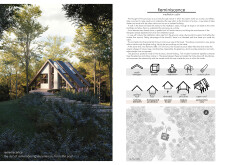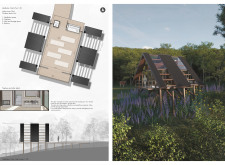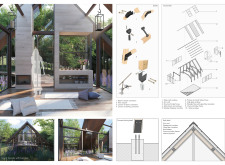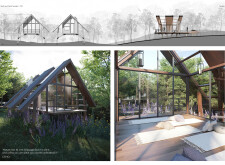5 key facts about this project
The meditation cabin showcases an approach to design that values connection with nature while providing a space for reflection and calm. Located within a sanctuary, the cabin becomes part of a larger story. It serves as a place for visitors to pause, offering a peaceful environment that encourages quiet contemplation and mindfulness.
Design Concept
The concept focuses on the experience of arriving at the cabin. Visitors walk along an elevated pathway that gently hugs the natural slope of the land. This creates a transition from the outside world to a space suitable for meditation. Familiar elements, like the gabled roof, create a comforting atmosphere that resonates with past visits to similar retreats.
Structural Approach
The structure rises from the ground on minimal supports, allowing the surrounding plants to thrive underneath. This design choice integrates the cabin into its environment, emphasizing the connection between built form and nature. The roof is designed with three sections that provide views of the forest through glass panels. This opens the space, letting in light and offering glimpses of the landscape outside.
Materiality and Aesthetic
The cabin primarily uses wood, an appropriate choice that mirrors the shapes found in nature, such as trees and branches. This material supports the structure while enhancing its links to the site. Glass is also a prominent feature, allowing those inside to experience the surroundings while providing protection. The glass section appears to hover within the wooden structure, creating contrast in a simple yet effective way.
Spatial Dynamics
The layout brings together two distinct elements that enhance the experience. The organic curves of the wooden structure meet the sharp lines of the glass box. This creates a balance that encourages visitors to reflect on their surroundings. The design invites people to engage with the cabin as well as the landscape, fostering a sense of harmony. This delicate balance between openness and shelter allows users to find peace in a thoughtfully designed space.






















































